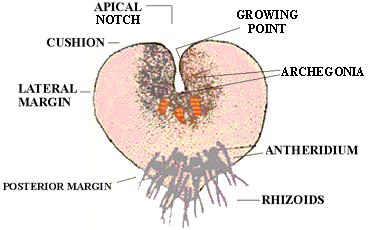|
PinkMonkey Online Study Guide-Biology
d) The Gametophyte
The gametophyte represents the sexual
haploid generation in the fern life cycle. The haploid
generation begins after meiosis in diploid spore mother cells.
The adult gametophyte is called a fern prothallus. It is
produced on moist, cool and shady soil, when a spore (n) germinates under
favorable conditions.

Figure 15.3 Mature fern prothallus (lower surface view)
The prothallus is very small (about 0.5-2.0 cms in diameter),
delicate and almost transparent. It is heart-shaped (Fig. 15.3) and flat
with dorsoventral symmetry. The prothallus has a deep apical notch. An
apical cell (growing point) is situated in the notch. The central part
of the prothallus is fleshy and is thick because of a number of cell layers.
This is called the cushion region. The peripheral part has only
one cell layer and is called the margin. Numerous hair-like rhizoids
develop from the lower surface of the posterior margin region. Rhizoids
help in fixation and absorption. The cells of a prothallus contain chloroplasts.
Therefore, it is photosynthetic and independent.
The prothallus (gametophyte) produces male sex organs
(antheridia) and female sex organs (archegonia) during sexual reproduction.
These develop on the lower surface facing the soil.
e) Reproduction
The fern life cycle shows both asexual and sexual reproduction.
Asexual reproduction takes place in the sporophyte (diploid) generation
while sexual reproduction takes place in the gametophytic generation.
|